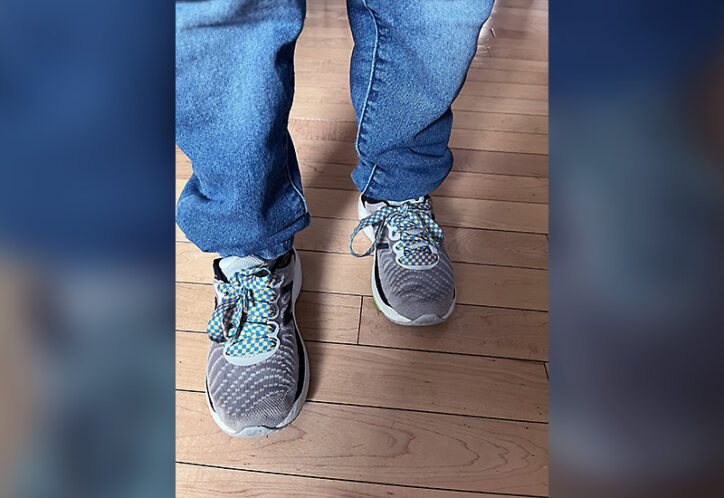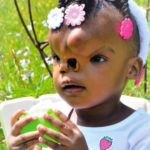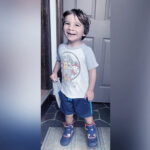Miles for Jack: Robin sequence and the bond between a family and doctor

For runners and non-runners alike, next week’s Boston Marathon is extra special.
It marks a beloved tradition for the city, and for many, it’s a chance to once again run for those who can’t and bring awareness to causes worth fighting for.
For 6-year-old Jack Ryan, this year’s marathon is a chance to cheer on his friend Dr. Cory Resnick, an oral surgeon at Boston Children’s, as he runs to spotlight Jack’s rare congenital condition, Robin sequence.
Babies with Robin sequence are born with an undeveloped lower jaw (micrognathia), a tongue positioned further back in the mouth than normal, and breathing difficulty due to airway obstruction. Some babies with Robin sequence may also have a cleft palate (an opening in the roof of the mouth); Jack was one such baby.
Friends from the starting line
Dr. Resnick and Jack first “met” when Jack’s mother, Jen, had a prenatal MRI that showed Jack would be born with micrognathia and a cleft palate.
The full extent of Jack’s facial differences wouldn’t be completely known until he was born, and the waiting was overwhelming for Jen and her husband, Matt.
“Nothing prepares you for that kind of news about your baby,” Jen says.
Clearing the hurdles
Jack arrived in February 2016 feisty and alert, but Robin sequence made it impossible for him to breathe unless he was lying on his stomach, so Jen and Matt held him on his belly all day every day for almost three weeks. When Jack was 18 days old, Dr. Resnick performed a jaw distraction to correct his breathing.
Jaw distraction, or mandibular distraction osteogenesis (MDO), works with the body’s natural healing ability to lengthen the lower jaw and pull the tongue forward to open the airway. Jaw distraction helps correct not only breathing issues, but feeding and sleeping difficulties caused by Robin sequence.
Jack was able to go home soon after his procedure.
Conquering the course
Over the last six years, Jack has returned to Boston Children’s to address other aspects of his Robin sequence.
He has undergone cleft palate repairs performed by Dr. Carolyn Rogers-Vizena and the team at the Cleft and Craniofacial Center and sleep studies with Dr. Dennis Rosen and the Sleep Center to address breathing difficulties he experienced while sleeping. He now uses a CPAP machine to help him breathe at night.
With these treatments and occupational and speech therapy, Jack has flourished. Today, he’s a happy and energetic kindergartner who loves baseball, basketball, and playing with his cousin.
“He’s doing awesome,” Jen says. “His teachers have said they would have never known he’s had multiple surgeries; he’s just a typical kindergartner. And we’re just rolling with the CPAP machine for now.”
Supportive fan base

Jack’s easygoing spirit is one of the reasons Dr. Resnick thought of him when he started training for the marathon. As Dr. Resnick’s patient partner for Boston Children’s Miles for Miracles, Jack will attend practice runs and plans to cheer on Dr. Resnick from the race route on Marathon Monday.
“When Dr. Resnick reached out about Jack being his patient partner, it was like ‘of course,’” Jen says. “We owe them everything, so it was a no-brainer.”
Learn more about Robin sequence or request an appointment with the Cleft and Craniofacial Center.
Related Posts :
-

A rare diagnosis: Zoey's new smile
Zoey Alford’s favorite TV show is Vampirina, the animated tale of a little blue-skinned vampire trying to fit in ...
-

A kiss from their sister: A family’s journey with cleft lip care
Kelly and Ben’s experience with cleft lip care at Boston Children’s Hospital spans multiple years and multiple children. ...
-

Logan shows off ‘big personality’ while overcoming cleft lip and palate
Three-year-old Logan Hatfield doesn’t simply ask to watch “The Lion King.” He lets out a loud roar and follows ...
-

Noisy breathing? It could be tracheomalacia
DJ is at his pediatrician’s office with his third bout of pneumonia this year. Katie wants to play soccer, ...





